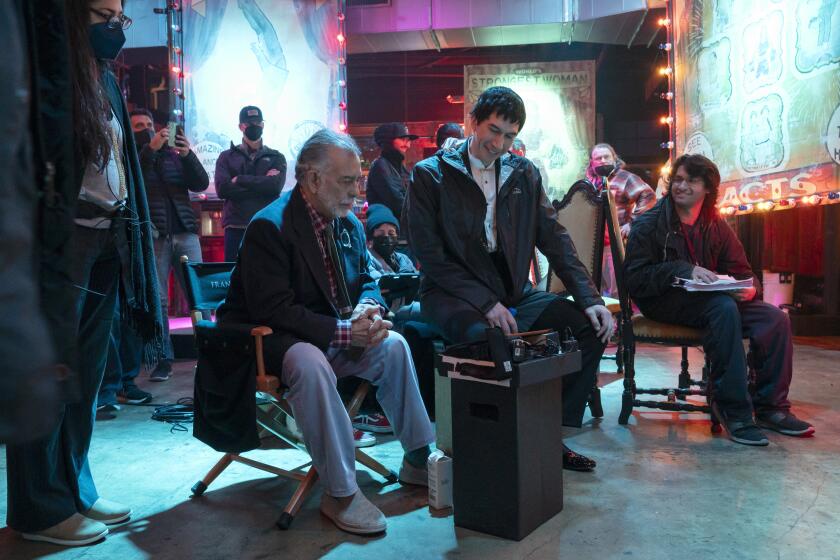Review: ‘This Is Where I Leave You’ is a fractious family affair
I can’t think of a family I’d rather sit shiva with than the Altmans of “This Is Where I Leave You.” They bury their father, Mort, pun no doubt intended, with the right mix of tears and unearthed resentments, and they take the blows life hands them seriously enough but in stride. As if they are nothing special.
This is exactly the charm of Jonathan Tropper’s novel on which the comedy/drama is based.
Director Shawn Levy gives us a star-studded cast for this sizable clan, starting with the matriarch Hilary (Jane Fonda), a child psychologist who’s been humiliating her offspring for years by detailing their development in her bestselling how-tos. Daughter Wendy (Tina Fey) is married with children, and not especially happily. Oldest son Paul (Corey Stoll) is the one who stayed around to mind the store, both figuratively and literally; Altman’s Sporting Goods is the family business. Phillip (Adam Driver) is the baby of the family, technically grown up but still acting out.
And then there is Judd (Jason Bateman), the middle child in more ways than one. The breakup of his marriage becomes the spinning top on which the action and conflict turns as much as Mort’s death.
The Altmans’ ordinariness is faithfully rendered on screen by Levy, who tends to play it safe in his films; the “Night at the Museum” series is typical of his style. Indeed, the ordinary becomes as much a defining quality of the narrative as the infidelity, arrested development, fertility issues, sexual issues and self-esteem issues that circle around, inflicting damage. At the Altmans’ lowest point, which is where the film catches them, the family represents a houseful of minor regrets and modest disappointments that will be recognizable to many.
Even religion, whose dictates have them relegated to uncomfortably low chairs in very close quarters for the requisite seven days of mourning, gets put in perspective. “This is where we put the Christmas tree,” one of the religiously non-observant Altmans observes, surveying the shiva chairs.
The performances are dialed down by the high-profile cast; no one in the ensemble tries to outshine the others, no scene-stealing here. It’s as if Levy set the button very close to mute. Director of photography Terry Stacey and the rest of the crew follow suit.
That might not be interesting enough, challenging enough for some. But for others weary of the intensity of family fiascoes that more typically make their way to the big screen these days, the slightly frayed but still warm bonds of this family may be appealing.
In a relatively rare move, Tropper adapted his novel for the screen. Fans of the bestseller should find the nipping, tucking and reshaping relatively seamless, but Tropper did switch the family’s name from Foxman to Altman. Whether or not the choice was an intentional nod to filmmaker Robert Altman and “This Is Where I Leave You’s” Altmanesque-sized cast, at times it can feel as if you are watching Robert Altman-lite.
The film is anchored by two deaths, really, and opens with the final throes of Judd’s marriage. He produces a radio talk show that stars popular shock-jock, Wade Beaufort (a deft politically incorrect turn by Dax Shepard). A few hours after wrapping the latest show, surprise birthday cake for wife Quinn (Abigail Spencer) in hand, Judd is the one suddenly shocked. Quinn is, shall we say, celebrating early with someone else.
Judd’s barely had time to settle into his depressed new life as a wronged and self-righteously resentful ex when Wendy calls to let him know that their dad’s dead. Mort’s demise is made rather indecorous by Hilary’s impatient removal of a breathing tube postmortem. In meeting Wendy’s protests with “What am I gonna do, kill him?” Hilary sets the tone for the family exchanges to follow.
With everyone gathered, the widow — in plunging neckline, too-short skirt and too-high heels — tells her children Mort’s dying wish was that the family sit shiva. Mourning rituals, whatever the religion, serve as handy conceits to force a family to spend time together, to frame a movie.
As the Altmans bicker and bond, extended family and friends begin to factor in, bringing plenty of conflict. Judd’s old girlfriend, perky Penny Moore (Rose Byrne), proves tempting. Paul’s wife, Annie (Kathryn Hahn), is desperate for a baby, so death or no death, sex will stay on schedule. Phillip’s brought his much older ex-therapist-new-girlfriend-possible-fiancée with him. Tracy (Connie Britton) represents all of his unresolved mother issues. Wendy’s high school sweetheart Horry (Timothy Olyphant) and his mom, and Hilary’s best friend Linda (Debra Monk) still live next door and significantly stir the pot.
As the complications pile up, the Altmans are a study in how to step around the messes rather than clean them up.
The mess, though, is where the best humor lies — the baby monitor mistakenly left on in the room where Annie and Paul are trying to produce an heir is one of the more memorable.
But the film is more interesting in the conversations that come after. As Hilary puts it one night to Judd, when it comes to talking to each other truthfully, they’ve gotten out of practice. But they’re working on it.
Things get wrapped up in a Hollywood ending that Tropper added — unnecessary, since loose ends are clearly a specialty of this clan.
And when the grown-up going gets tough, the one thing you know is that the Altmans won’t abandon one another. Which makes “This Is Where I Leave You” not earthshaking by any stretch, but somehow reassuring.
------------
‘This Is Where I Leave You’
MPAA rating: R for language, sexual content and some drug use
Running time: 1 hour, 43 minutes
Playing: In general release
More to Read
Only good movies
Get the Indie Focus newsletter, Mark Olsen's weekly guide to the world of cinema.
You may occasionally receive promotional content from the Los Angeles Times.











